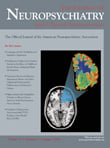Charles Bonnet Syndrome: Two Case Reports
To the Editor: Charles Bonnet syndrome is a rare disorder with estimated prevalence of 0.8% in low vision group, 1 0.6% in the elderly, 1 and 0.4% in Asians. 2 True Charles Bonnet syndrome is rare and most cases have Charles Bonnet syndrome plus. 3 These are supposed to be release hallucinations that occur when the brain does not get stimulations from the eyes. Despite many case reports, there is a lot to learn about the syndrome and the exact pathology is still unknown. 4 Here we describe two cases of true Charles Bonnet syndrome that presented with different anatomical lesions.
Case 1
A 60-year-old man presented with a 6-year history of abnormal behavior and staggering gait; illness was progressive and insidious in onset. He was allegedly seeing some insects that others could not and he could clearly demarcate them from the surroundings. The bugs were present everywhere and he became distressed as he tried to remove them from his clothes and food without success. He washed his hands very frequently to get rid of them. His wife complained that in the last few days before the consultation his gait had changed and he had collided with objects on either side of his path. His medical and psychiatric histories were unremarkable. His neurological examination revealed the presence of bitemporal heteronymous hemianopia and a CT scan of the head showed optic chiasmal meningioma. The patient was sent for neurosurgery.
Case 2
A 75-year-old man came to us with the complaint of seeing some faces that other could not see. He did not have sight in his right eye due to an injury during adulthood, but he could see a face with the right eye and was able to describe it in detail. The face was constantly present and was only relieved when he went to sleep. For the previous 5 years he had developed similar visual hallucinations in the other eye, which progressed gradually. In the left eye he began to see a plethora of faces with distorted features that moved toward him and disappeared when they reached him. He could delineate every face from the crowd. He could relieve this vision by widening his eyes, but the problem increased if he blinked or kept his eyes half closed. The images disappeared during sleep. His medical and psychiatric histories were unremarkable and neurological examination revealed the constriction of the visual field in all quadrants. He was sent for ophthalmologic examination and his visual acuity was found to be 20/60 in the left eye. Ophthalmoscopic examination disclosed primary optic atrophy in the left eye. No cause could be identified for this atrophy as the patient declined a neuroradiological examination. The right eye had corneal opacity making fundoscopy impossible.
Discussion
Charles Bonnet syndrome is diagnosed when a person has complex, persistent or repetitive, stereotyped visual hallucinations, and has insight into the disease in the absence of other psychopathology. 5 , 6 Poor vision and sensory deprivation are common precipitants. 5 , 6 The syndrome has to be differentiated from the other causes of complex visual hallucinations that occur transiently (e.g., hypnogogic hallucinations, epileptic phenomenon, treated Parkinson’s disease, Lewy body dementia, and migraine) or causes of persistent complex visual hallucinations (e.g., peduncular hallucinations that occur due to the brainstem damage, delirium tremens). 7 None of these were present in our patients. Most patients retain full insight into hallucinations and can stop them by closing or opening their eyes, 7 as evidenced by our second case.
Hallucinations in Charles Bonnet syndrome have been reported to occur due to damage to the visual pathway, as in partial blindness, after cataract surgery, and in optic nerve damage caused by sella tursica meningioma. 6 , 8 These kinds of visual pathologies were present in both of our patients. The hallucination content appears to be stable across cultures; distorted faces with prominent eyes and teeth are commonly reported 9 and hallucinations of insects are also known. 6 Despite an exhaustive search we could not find any literature that could correlate particular types of visual hallucinations with the particular neuropathology. Hence we still need to learn more about Charles Bonnet syndrome and more cases are required to understand the pathology.
1 . Shiraishi Y, Terao T, Ibi K, et al: The rarity of Charles Bonnet syndrome. J Psychiatr Res 2004; 38:207–213Google Scholar
2 . Tan CS, Lim VS, Ho DY, et al: Charles Bonnet syndrome in Asian patients in a tertiary ophthalmic center. Br J Ophthalmol 2004; 88:1325–139Google Scholar
3 . Howard R, Levy R: Charles Bonnet syndrome plus: complex visual hallucinations of Charles Bonnet syndrome type in late paraphrenia. Int J Geriatr Psychiat 1994; 9:399–404Google Scholar
4 . Eperjesi F, Akbarali N: Rehabilitation in Charles Bonnet syndrome: a review of treatment options. Clin Exp Optom 2004; 87:149–152Google Scholar
5 . Gold K, Rabins PV: Isolated visual hallucinations and the Charles Bonnet syndrome: a review of the literature and presentation of six cases. Compr Psychiatry 1989; 30:90–98Google Scholar
6 . Braun CMJ, Dumont M, Duval J, et al. Brain modules of hallucinations: an analysis of multiple patients with brain lesions. J Psychiatry Neurosci 2003; 28:432–449Google Scholar
7 . Manford M, Andermann F: Complex visual hallucinations: clinical and neurobiological insights. Brain 1998; 121:1819–1840Google Scholar
8 . Plesnicar BK, Zalar B, Bocic MB: The Charles Bonnet syndrome: a case report. Wien Klin Wochenschr 2004; 116(suppl 2):75–77Google Scholar
9 . Santhouse AM, Howard RJ, Ffytche DH. Visual hallucinatory syndromes and the anatomy of the visual brain. Brain 2000; 123:2055–204Google Scholar



